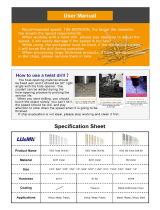
20
Checking for Leaks
When the boat is placed in the water, immediately check around the sensor for
leaks. Note that very small leaks may not be readily observed. Do not to leave the
boat in the water for more than 3 hours before checking it again. If there is a small
leak, there may be considerable bilge water accumulation after 24 hours. If a leak
is observed, repeat “Bedding” and “Installing” immediately (pages 12 and 13).
Operation, Maintenance, & Replacement
How the Valve Works
THE VALVE IS NOT A WATERTIGHT SEAL! The sensor incorporates a self-
closing valve which minimizes the flow of water into the boat when the insert is
removed. The curved flap valve is activated by both a spring and water pressure.
Water pushes the flap valve upward to block the opening, so there is no gush of
water into the boat. Always install the insert or the blanking plug secured with the
cap nut and safety wire for a watertight seal.
Using the Blanking Plug
To protect the insert, use the blanking plug:
• When the boat will be kept in salt water for more than a week.
• When the boat will be removed from the water.
• When aquatic growth buildup on the insert is suspected due to inaccurate
readings from the instrument.
1. The O-rings must be intact and well lubricated to make a watertight seal. On the
blanking plug, inspect the O-rings (replace if necessary) and lubricate them with
the silicone lubricant supplied or petroleum jelly (Figure 12).
2. Remove the insert from the housing by removing the safety wire and
unscrewing the cap nut (Figure 4 or 5). This will jack up the insert. Remove the
insert with a slow pulling motion. Replace it by sliding the blanking plug into the
housing.
NOTE: In the very unlikely event that the valve breaks, replace the housing the
next time the boat is hauled.
3. With the blanking plug fully inserted, screw the cap nut several turns until the
threads are engaged. Continue to tighten the cap nut completely. Hand tighten
only. Do not over tighten.
NOTE: The blanking plug must be fully inserted in the housing and the cap nut
screwed on completely for a watertight seal.
4. Reattach the safety wire to prevent the blanking plug from backing out in the
unlikely event that the cap nut fails or is screwed on incorrectly.
Winterizing
After the boat has been hauled for winter storage, remove the blanking plug to let
the water drain away before reinserting it. This will prevent any water from
freezing around the blanking plug and possibly cracking it.






















